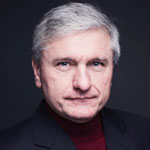Energy model G in Humanitarian socionics. What is it?
Why was the Energy Model developed in Humanitarian Socionics?
The focus of modern socionics should be on the modeling of energy and information processes: how energy generates information - a new ordering, a valuable experience, a proven knowledge. After all, knowledge (information as a tool), even the most reliable as it gets, without use, is not worth much. And in order to start using knowledge, you need energy.
A word as a means of information transmission onto a person or a group of people is ineffective by itself if one does not make energetic preparations, that help excite and interest a person in what you are saying (we need to elevate a person to a higher energy level first). Practicing psychologists, PR specialists, and political strategists have long understood this. The energy of the psyche begins to come to the central stage.
Based on such considerations, the Humanitarian Socionics has developed an energy model of the psyche, which more closely corresponds to the criterion of optimal life activity in the material world.
The energy model of a socionics object does not cancel Model A but complements it with a single model of energy-informational metabolism (EIM).It describes the qualitative transformation of the energy within the sociotype in the process of interaction with the surrounding reality.
The energy model consists of four blocks:
1.1. Social mission block in the Energy Model G. Humanitarian Socionics
It is the most powerful block, according to which a person confidently realizes themselves in a society (at a long communicative distance). With the help of this block, the carrier of the sociotype can regularly solve complex challenges facing them using their own capabilities and with maximum efficiency. From a point of view of the society, the social mission is an extremely concise set of instructions that describes without going into a detail what are the societal expectations for the person, i.e. what the goals are and how a person should go about reaching those goals throughout their existence in a society. The leadership block.
1. Leading - leading, stable, external. The "captain" of the team, the function of decision-making and resource allocation. Manages through encouragement.
2. Creative - leading, unstable, external. Implements mission of the type, implements it according to local conditions (fully takes them into account). It receives an energy boost from the Leader.
1.2. The block of social adaptation in the Energy model G. Humanitarian socionics
With the help of this block, the carrier of the sociotype adapts to social conditions. The block is well trained to solve regular, but not creative, tasks. The survival unit.
3. Role-playing - driven, stable, external. Consciously trained according to social norms. In the absence of external influences, the activity of this function decreases quite rapidly.
4. Launching - driven, unstable, external. Accelerates activity (the point of imprinting - an impulse that initiates the Leader), triggers the sociotype to perform socially significant tasks. At a close range, activation leads to the opposite effect.
1.3. The block of creative self-realization in the Energy model G. Humanitarian socionics
According to this block, the carrier of the sociotype creatively manifests themself at a close communicative distance, in the territory that they consider their own. They are able to spontaneously (but not regularly) solve complex non-standard tasks. Actions of the block appear demonstrative in nature, aimed at evaluating others (or provoking a reaction). This is a block of personal self-affirmation.
5. Demonstrative - leading, unstable, internal. The use is often contradictory to what is normal under local conditions, manifests suddenly as an impulsive action that attracts attention of the observer.
6. Manipulative - driven, stable, internalized. Long-term memorization of behaviors and habits. It replenishes energy reserves and sets a smooth way to control the type.
1.4. The block of inflation in the Energy model G. Humanitarian socionics
The weakest block, actions on it requires a lot of effort and the results are usually not successful. While taking actions in this block, inflation (bloating) occurs - more and more energy is spent until the system is overwhelmed and the energy release occurs (you can compare this with inflating and bursting a soap bubble), and as a result the energy of the system is quickly depleted (actions are carried out with minimal efficiency).
7. Braking - driven, unstable, internal. Its perception and its use lead to inhibition. The point of energy loss, produces the least adequate result, shows the greatest resistance to workloads.
8. Controlling - leading, stable, internal. Control via restrictions. The point of least resistance, the most problematic position (the problem of the discrepancy between word and action - "I know, but I can't"). Controls what is happening in the immediate environment, dominates, imposes its opinion, but the carrier of the sociotype is not inclined to do anything or actively do anything for this function.
Distribution of energy between the functions of the sociomodel:
The Leading (1) and Demonstrative (5) – Energy-maximum - functions are energetically strong, taking away the lion's share of the total energy consumption of the socionic object;
Creative (2) and Manipulative (6) - Energy-optimal - functions that take away as much energy as is needed to solve the problems at hand;
Role-playing (3) and Braking (7) – Energy-minimum - functions that support the functioning of the socionics object at a lower energy level;
Launching (4) and Controlling (8) – Energy-pessimum - functions that convulsively spend leftover energy only in the most extreme cases.
Comments

Тихон Орлов
30.05.2025 22:55
Здравствуйте! Заметил интересный момент, и хочу послушать вашу точку зрения! А как понимать если стимул по активационной работает на дальней дистанции хорошо а на ближней противоположно, то почему у дуала она на близкой дистанции? А ещё очень хочу понять тех людей кто пишет что у вас бред и тд. я считаю что гуманитарная соционика и ее модель Г это золото для типирования и понимания соционики , ведь это объективно ! А то откуда есть балаболы! Спасибо заранее за ответ!

Jared Vaughan
24.04.2023 17:25
You need to explain why Model G is ordered the way it is. And give an example using a type. Example: LII L - T - R - S I - E - F - P

Алекс
07.02.2023 09:25
Главный вопрос, а зачем придумывать новый велосипед? Какую задачу решает эта новая структура? Спасибо

Андрей
19.04.2022 13:03
Виктор Владимирович, я стараюсь разобраться в модели G и заметил, что сознание туго принимает её. Это связано с засевшей там моделью А, но не только. Модель А хороша тем, что делит функции на хорошо и плохо осознаваемые, и это соответствует действительности. В модели G в блоке социальной миссии рядом находятся 1 и 8 функции из модели А. Блок описывается как сильный, реализации типа и т.д. Но с этим трудно согласиться, ведь по 2й функции модели G (8й по А) я "не думаю"! Пусть она сильная и на практике работает в паре с 1й, прямая постановка их на одну ступень не соответствует самоощущению. Предлагаю дополнить описание модели G, уточнив, что 2я работает в паре с 1й, но "незаметно". p.s. В другом своём комментарии "болевая как пусковая" ошибся, пожалуйста, удалите.

Андрей
19.04.2022 12:49
> Болевая как Пусковая... ну приведите хоть один пример... Анна, насколько я понял, "болевая как пусковая" работает так: если человек видит вокруг себя что-то неправильное по своей болевой функции, он "запускается" в работу. В статье так и написано: реагирует на изменения на дальней дистанции. То есть, если человека непосредственно плющат по болевой, он "запускаться", конечно, не будет. А вот если где-то... Например, Аналитик видит, что государство притесняет слабых (ЧС), начинает вести общественную работу против этого. Получается диссидент. Искатель видит, что на почте люди в очереди ругаются (БЭ), создаёт электронную очередь.

Анастасия (админ)
22.01.2021 19:50
Более подробный ответ на вопрос об отличиях в позициях функций в моделях G и А - https://socioniks.net/freevideo/?id=99

Виктор Гуленко
15.09.2020 11:31
Конечно, нумерация функций не совпадает. Модель G на язык модели А не переводится без грубых искажений.

Катерина
07.09.2020 12:51
Добрый день! Скажите пжл, получается нумерация функции не совпадает с моделью А. Например, функция 5 (суггестичная 1 мерная) в модели G - это функция 8 контролирующая слабая?

Анна
26.06.2020 08:36
Очень запутанно. Статью нужно дополнить пояснением по каждому из восьми знаков. В нынешнем виде она интересна, но абсолютно неинформативна. Если ее цель - привлечь на обучение, то я не пойду, ибо такое непонятное обучение и будет... Болевая как Пусковая... ну приведите хоть один пример...

Анастасия (админ)
22.03.2020 16:08
Яна, по Модели G тормозная функция Маршала это -R (интровертная этика отношений), а не E (экстравертная этика эмоций).

Яна
07.03.2020 19:39
і маршала емоції тормозять

Яна
07.03.2020 19:38
Анастасия, я сказала лише за ту функцію а не про всю модель. За моїми спостереженнями в мене тормозна екстравертна функція , а інтровертної "нема" . гравець

Анастасия (админ)
26.02.2020 22:08
Людмила, Яна это Гуманитарная соционика и Модель G, которую разработал Виктор Гуленко более 20 лет назад, совершенствуя соционику. Время, опыт, эмпирические наблюдения лишь подтверждают, что функции в типах стоят именно так, как это предлагает Модель G. Никаких ошибок и неточностей нет. Будьте внимательны к жизни, к типам, и вы увидите, что миссия типа будет выполняться именно тогда, когда человек начинает действовать по такой формуле. Например, Искатель, который живет по формуле IP (а не IL, как в Модели А) или Инспектор по LS (вместо LF), выполняют свою социальную миссию намного эффективнее, реализуются в социуме и семье успешнее, и чувствуют себя счастливее.

Яна
26.02.2020 11:48
Тормозна екстернальна!!! Наприклад, в наставника -F а "слаба" +S

Сахатмурадова Людмила
04.02.2020 19:23
Да, статья запутанная. Если сильно напрячься и соотнести с моделью А то что то можно понять. Номера функций перепутаны. Но их содержание можно угадать и сменить номерацию. И только тогда информация совпадает с уже известными выкладками по модели А. Не стоил так путать читателей и любителей соционики

Виктор Гуленко
19.02.2019 19:16
По принципу позитивизма - негативизма.

Анна
19.02.2019 15:44
Добрый день! Подскажите, пожалуйста, по какому принципу расставляются знаки функции в модели G? Заранее спасибо)

Гамлет
24.11.2018 16:14
Благодарю, Анастасия, за обратную связь)

Анастасия (админ)
19.11.2018 10:46
Здравствуйте, Гамлет, Александр! Очень приятно ваше небезразличие и внимание к Гуманитарной соционике и нашему сайту. Мы ценим и учитываем мнение всех пользователей сайта. Поиск по сайту сделаем, не волнуйтесь. Благодарим за ваше участие!

Гамлет
18.11.2018 23:31
Да, подача материала перечеркивает всю глубину и логичность данной модели((( Даже обидно. Где целостная модель, на которой представлены все типы? Почему нет детального описания, которое бы не запутывало начинающих изучать, а, наоборот, полностью раскрывало бы модель? Где логическая структура сайта? И почему нет реакции администрации сайта на комментарии? Неужели нет стремления сделать сайт лучше, чтоб он не вызывал подобных реакций?

Александр
31.10.2018 21:41
Вы не найдете тут очевидных вещей на очевидном месте - администрация сайта не считает нужным делать его логически структурированным. Как говорится, ищите инфу интуитивно, возможно - она есть =)))))))))

Анна
11.09.2018 18:54
Почему нет схемы-рисунка. Трудно представить, как это выглядит.

Анастасия (админ)
01.12.2017 16:08
Да, Игорь, это не одно и то же. В Гуманитарной соционике мы используем Модель G - за основу взят энергетический обмен, а не информационный, как в Модели А.

Игорь Дрозд
30.11.2017 16:22
Модель G отличается от Модели А?
Author
News
Important to know


Normalizing subtype. DCNH – 4 variants of the type in socionics
Subtypes
The Female Inspector (LSI) Is A "Tough Nut To Crack". Description of female types in Humanitarian Socionics
Video: 1 h 27 min (in Russian)
Don't miss this, it's also
Interesting

Temperament
Flexible-maneuvering temperament in socionics
Carriers of the flexible-maneuvering temperament combine high energy with an ability...

Temperament
Linear-assertive temperament in socionics
Carriers of the linear-assertive temperament are recognized in the socion by the greatest...

Aristocrats and Democrats in Socionics
The aristocrats are representatives of the Beta and Delta quadras. For these types, the predominance of vertical...
